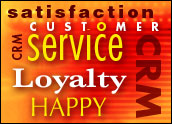
Never before has the voice of the customer been so loud. And never before have companies been so keen to not only pay close attention to the wants, likes, experiences, preferences, opinions, suggestions and complaints of customers, but to carefully analyze and act upon the information in a systematic fashion.
In June, Aberdeen published a benchmark report on customer feedback management that examined the use, the experiences and the intentions of more than 300 diverse enterprises. The goal was to create a road map for companies that aim to collect, integrate, analyze and act upon customer feedback across multiple touch points through Best-in-Class use of related solutions and capabilities.
The Aberdeen report reveals large performance disparities between Best-in-Class organizations and Industry Average and Laggard companies. Best-in-Class organizations are more than eight times more likely than Laggards to increase customer satisfaction, for example, and more than 26 times more likely to increase customer retention. This finding speaks to the value of customer feedback management in terms of maintaining and enhancing the value of a company’s relationships with existing customers. Best-in-Class organizations are also more than 19 times more likely than Laggards to increase customer-focused innovation, which speaks to the value of customer feedback management as an engine for new product development and continuous business growth.
Citi Banks on Customer Satisfaction
The report contains an abundance of success stories. Among them is Citi, the world’s largest bank, which in 2006 launched a six-month pilot to test a customer feedback management system. The company wanted to show that it was serious about focusing on the customer experience, according to William Wilson, executive vice president of customer insights at Citi.
Citi installed kiosks in all of its branches with big signage: “Tell us how we’re doing.” The program took off immediately and was subsequently expanded to reach a greater number of the company’s 200 million customers around the world. “At first, our frontline managers were concerned about opening the floodgates,” says Wilson. “But quickly they saw the power of being able to immediately get the customer feedback they needed.”
The program helped Citi move from fourth to second quartile performance in industry-wide customer satisfaction in less than a year, according to the J. D. Power and Associates Retail Banking Satisfaction Study. While high customer satisfaction obviously won’t do much to offset Citi’s recent bout of multibillion-dollar credit-related losses, it could play an instrumental role in helping the company regain its foothold in the long run.
Hertz Drives Change and Innovation
Another success story is Hertz. With more than 8,000 locations in 145 countries, Hertz ranks as the largest general use car rental company in the world. Like most major business-to-consumer companies, Hertz has long had a formalized process in place for collecting customer feedback. It has only been with the past 18 months, however, that Hertz has implemented an enterprise-wide customer feedback management system, taking the company’s ability to respond to customer opinion to a whole new level.
“We wanted to become proactive about getting a larger sample of feedback from our customers,” explains Brian Dickerson, vice president of customer care at Hertz. “And we wanted to be able to look at customer feedback on a real-time basis.” At the same time it implemented the new system, Hertz switched from using a basic customer service index as a numerical indicator of progress to the Net Promoter Score (NPS). The score is tracked on a global basis across all Hertz operations, including franchise locations. The results are rolled up on a regional and country level, providing a global basis for comparison.
“Nobody in the organization is exempt from being held responsible for improving that score,” says Dickerson, noting that the CEO reports to the board of directors on how the company is performing in terms of NPS and what actions are being taken to improve the score. At the same time, the focus on NPS tells only part of the story. “You have to use NPS as a tracking mechanism, but you also have to get direct customer feedback to get down to the root cause analysis in fixing a problem.”
Hertz obtains customer feedback through surveys sent to a random sample of customers via e-mail and also in response to an invitation that appears on the back of customer invoices. Response rates are high, partly due to the fact that the surveys are limited to four questions, including one that pertains to the customer’s overall level of satisfaction with Hertz and their likelihood to recommend the company. Customers also have the option to provide brief comments about their experience. “The comments are what you use to drive some difference in the service you’re providing and to drive change and drive innovation,” says Dickerson.
Allstate Puts Customers in Good Hands
Finally, consider Allstate, the largest publicly held personal lines insurance company in the United States, with more than US$37 billion in revenues. Allstate’s advertising campaigns ask consumers: “Are you in good hands?” Using a sophisticated customer feedback management system, Allstate asks consumers the same question, and a host of others, with respect to their day-to-day experiences with the company. And this time it gets an answer.
That’s because Allstate systematically collects customer feedback through a number of different tracking instruments. One instrument, which the company is currently in the midst of re-architecting, captures customer feedback with respect to the claims process. According to Pablo Azar, vice president, marketing strategy and consumer insights at Allstate, the new instrument will serve as an overall measurement system, integrating feedback from both Allstate employees and from transaction-specific surveys that focus on context-sensitive customer experiences. For example: How was your experience interacting with the claims department? How was your experience interacting with the call center to open a policy? How was your experience interacting with an agent to change a policy?
Once implemented, the system will ensure that all pieces of customer feedback flow through a centralized database. There the feedback can be more effectively analyzed and shared — in part through the company’s customer loyalty/ satisfaction measurement publication, a monthly report it makes available to shareholders on a quarterly basis. By improving its customer feedback management technology and process capabilities, Allstate customers can gain confidence that they’re not only in good hands, but that they also have the company’s ear.
A New Era of Customer Influence
In the past, dissatisfied customers wishing to complain about a product or service had only a few options at their disposal. These included telling a manager, sending a letter to the company’s corporate headquarters, or filing a report with the Better Business Bureau. Moreover, most customers were relatively tolerant of brand mediocrity and under-performance, knowing their alternative choices were limited and their opinions would likely have little, if any, impact anyway.
Today, by contrast, customers have a soapbox of unprecedented reach and influence by which to air their grievances, voice their delights and share their brand experiences. With the rise of social media, control of a brand message no longer resides with the company selling the products and services but with the consumers buying them.
A number of other trends, including corporate transparency, marketing authenticity and brand disloyalty, are also conspiring to usher in this new era of customer influence. It’s an era in which companies have no choice but to actively encourage customer feedback and to treat customers as strategic assets in the incessant quest to improve operations, marketing, research, product development and the overall customer experience.
That means moving beyond ad hoc surveys and point solutions that focus on a single channel or a single product or a single aspect of the customer experience. It means putting the right technologies, business processes, organizational resources and performance metrics in place to capture, analyze and act upon customer feedback in a holistic fashion, across all touch points and all stages of the customer lifecycle, on an ongoing basis.
Jeff Zabin is a research fellow for the Aberdeen Group, where he covers customer management technology. His current research agenda includes such topics as social media monitoring, marketing dashboards, word-of-mouth marketing, customer feedback management and mobile marketing. He can be reached at [email protected].




















































